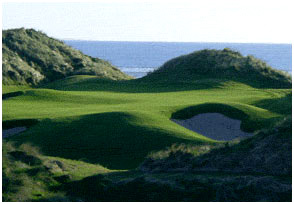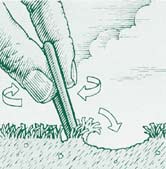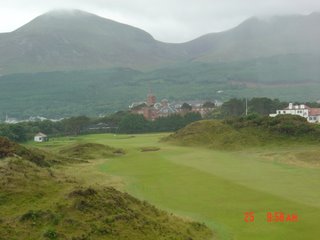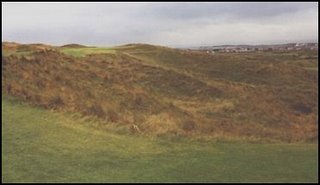
My first trip to play golf in Europe was to Ireland about ten years ago. A friend who was born and raised in Northern Ireland arranged the trip and we went in late September. He is an aggressive type 'A' personality and we played about 12 times in 7 days. Ireland has 32 counties (26 in the Republic and 6 in the North). During our brief stay on the Island we drove through 20 of them while making a complete circuit of the country.
We started in Dublin, traveled South, then West, then North, then East before traveling south to Dublin again. We played five courses on the top 100 list (Royal County Down, Royal Portrush, The European Club, Lahinch and Ballybunion) and several others that are not (Ballyliffin in County Donegal, The K Club and Druids Glen).
I credit this trip for infecting me with the golf bug. I've been addicted ever since.
I have returned to Ireland many times on golf trips and played throughout the country including at Tralee, Waterville, Old Head, Portmarnock and Killarney. Irish weather in late September can be hit or miss. On this trip it was a miss. Wind like you cannot believe; rain; cold; damp. We usually played 36 holes each day and would then drive between 2 and 6 hours to the next course. Luckily, we had a driver to take us around. He was a farmer whose crops were awaiting harvest and he was doing this for spare income.
Having grown up in America I have a certain perception of what a hotel room is supposed to be like and what constitutes a meal. These were all shattered on my first trip. The first thing you grasp is that Ireland is basically still a third world country outside of Dublin. I in no way mean that in a derogatory or negative sense, but they have limited infrastructure. Things have certainly changed in the last 10 years as Ireland has joined the EU and become a massive beneficiary of roads and other projects, but the Irish countryside is still based on a centuries old agrarian economy.
Almost all the roads we traveled on were two lane roads with barely enough room for two small cars to pass. On a map, two locations appear to be 60 miles apart. In the States it would more or less take an hour to travel between them. In Ireland it would probably take the better part of three hours. I found it astonishing that most people we met on the trip had never left the county they lived in. Even with a driver and a map it was very difficult to get around. The road signs in each town only point the way to the next town. If you are looking for a town that is 15 miles ahead and pull into a gas station or a pub to ask for directions, you may as well be asking for directions to Des Moines.
There is also no such thing as a hotel chain or a recognizable brand name in Ireland. We stayed at B & B's or small country hotels throughout the country, most of the time in small villages where we were playing golf. In the United States you can stay at a Hyatt or Hilton or some other known brand. Not in Ireland -- everything is local, and it is great. What a refreshing break from the bland sameness that America has become. They may not be luxurious, but they have personality. The rooms are miniature, the showers alternate between ice water and scalding hot, there are no hair dryers and if you are lucky there are three channels on the TV. We have stayed at our fair share of "Marine" hotels that saw their best days in the 30s or 40s. Paper thin walls and no room service.
Although they lack amenities they make up for it in charm -- like a night porter making you toast and coffee at 5 am so you could have something to eat before a long drive. Or the owner fixing you sandwiches upon a late arrival.
On our first morning in Ireland we were introduced to something that has become a beloved part of our trips to the British Isles - the full fry. You have to understand we did not stay at 4 star hotels -- No Adare Manors or K Clubs for us. The first time you get the eggs, sausage, bacon, blood pudding, tomato, mushrooms, hash browns and toast you think to yourself, wow! This is not a country where you have a bowl of cereal with skim milk or a bagel.

I fell in love with Ireland immediately. There is an understated simplicity to the place that I really liked. The countryside is spectacularly beautiful throughout. It is not uncommon to see a rainbow every day. There are rolling hills everywhere: more shades of green that you can describe; old stone walls that mark the farmers fields. Rounding the bend on a curved road we were once startled to see a farmer walking his cows down the middle of the road on their way to an alternate field. It is a timeless scene.

Ballybunion's lovely 12th hole
Although normally a Scotch drinker, while in Ireland I only drink only Guinness. Under U.S.D.A. regulations the Guinness that is imported into the U.S. must be pasteurized. The Guinness here is unaltered and it tastes different -- and better. One of life's simple pleasure is enjoying a pint of Guinness in Ireland served at the correct temperature after it has been properly poured.
I was also very surprised at how knowledgeable the Irish people were of the U.S., in particular U.S. politics. Even in remote villages you can engage in a discussion on a variety of topics.
Lahinch (ranked #73 in the world), in some ways is a cow pasture. One of the things you hear over and over that makes Pine Valley such a great golf course is that you can't see the other holes when you are playing the hole you are on. In fact you can on several holes, but the point is that you do feel a sense of isolation throughout the round.
The adventure at Lahinch begins on the first hole, which has a plateau green. Try stepping up to this first tee after flying all night with no sleep. Where do you aim again?
 Welcome to Lahinch. The tricky first hole.
Welcome to Lahinch. The tricky first hole.If there is a polar opposite to Pine Valley, it is Lahinch. My advice to you at Lahinch is be ready to duck at any time. It is wide open. The fourth, fifth and eighteenth fairways literally criss-cross, I kid you not. Talk about hazards in front of the green? How about the fourth hole named "Klondyke". It has a fifty foot sand dune in front of the green, making it a blind approach on a 400+ yard hole! The narrow fairway snakes through the dunes as seen below.
 The tough fourth hole at Lahinch, "Klondyke"
The tough fourth hole at Lahinch, "Klondyke"The completely blind par three fifth, the "Dell" hole, pictured below, is reportedly the site of many a hole in one, sometimes with the minor assist of a caddie who gets a much enhanced tip.

The fabulous blind Dell hole at Lahinch
Look at the comments of those that have completed playing the top 100 golf courses in the world. Coincidentally or not, almost all had poor weather when they played Lahinch. Bottom line, Lahinch has bad weather. Having been there twice I can attest to rain and wind both times. The second and third holes, which are not really shielded by the dunes, play impossibly difficult in windy, rainy conditions. Wind in Ireland is different than where I live. It is not an exaggeration to say that you can play in a four-club wind at Lahinch.
Why is Lahinch on the top 100 list? It's hard to articulate, but it should be there. Like the Old Course at St. Andrews, Lahinch takes time to appreciate. It was designed by Old Tom Morris and Alister Mackenzie revised the layout in the 1920s. Despite all its shortcomings, Lahinch has an intangible quality that is unmistakably Irish. It is a cult course in the same vein as a Cruden Bay, North Berwick or Prestwick. Love it or hate it, but play Lahinch once and you will always remember it.

I am a fan of Ballybunion and agree that it is a pure links course. The first hole is a good starting hole, with an unusual hazard down the right hand side - a cemetery. The last time I played Ballybunion was two years ago and we had a 7:00AM tee time, the first group out. It was a brilliantly sunny, warm day and the round was very pleasant. My only criticism of the layout is that the 4th, 5th and 6th holes are all routed in the same direction, and all into the prevailing wind. This makes a total of 1,400 yards into the wind that can wear you down early in the round. I'm a bigger fan of routings such as Caroustie and Royal Portrush that have more change in direction. Despite this shortcoming, Ballybunion is a worthy entrant in the top fifteen courses in the world.
 The serene dunes landscape of Ballybunion
The serene dunes landscape of BallybunionI am also a fan of the second course at Ballybunion - the Cashen. It is a new course designed by Robert Trent Jones but looks like its been there a long time and is a fun and imaginative routing. Ballybunion has a new American style clubhouse that doesn't really fit the course or the surroundings. Despite these shortcoming, golf in Ireland can hold its own with golf in any region of the world.









